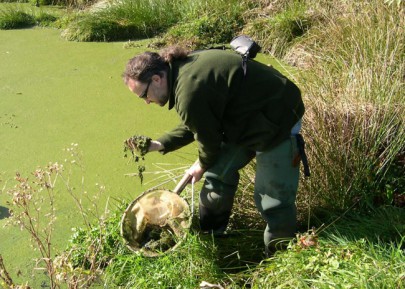How to use this guide
In this section
1) How do I find and collect algae?

Sampling for algae.
Some hints on where to look for algae are given on the Algal habitat section. Procedures for sampling them and observing them with a compound microscope are given on the Sampling Tips page. Planning a monitoring program requires regular sampling over time, and suggestions are given on the Using Algae as Long Term Indicators page.
2) What are the algae in my samples?
The Identification Guide will help you answer this question. The guide contains several components to help you. The first is a key that allows you to work in steps towards an identification using the features available in your material. This may direct you to an identification, or present a short list of taxa to choose between. Associated with the key is a glossary, where as many technical terms as possible have been defined, usually with illustrations.
If you are new to the world of algae, we strongly recommend browsing the Descriptions of Major Groups, which are brief but provide information and examples, with links to definitions of terms. Familiarity with these will make the key easier to use.
Note: the key is not structured according to evolutionary relationships (unlike the Descriptions of Major Groups).This is because the features uniting such groups are often much more subtle than other features, such as gross morphology, which can be used to make progress deeper in the key much more easily.
3) How does the presence of this alga help me to judge the habitat quality of the water body?
The first thing to note is that algae are natural, essential and expected components of aquatic habitats. The presence of algae - even in some abundance at some times - does not necessarily indicate degradation of water quality. Algae exhibit responses to light, temperature, and frequency of flooding, as well as to nutrient concentrations. A long stable period in summer may therefore generate algal biomass without indicating excessive eutrophication.
Furthermore, this key is a broad tool. One of the processes thought to generate new species is exposure to different environments - and most identifications here are to genus, not species. Accurate characterisations of the conditions tolerated by many genera are also lacking.
However, some general patterns can definitely be useful, particularly in extreme cases. This includes cases where your results should be reported to the authorities. Such results would include occurrence of sewage fungus, abundant cyanobacteria that could be toxic, or occurrence of Didymo (especially in the North Island).
Eutrophication may be indicated by a change in the type of taxa you see, and their abundance. The Indicator Taxa section allows you to contrast communities of different types, such as those from natural ponds and wetlands with those from water treatment ponds. A change from the former to the latter community, especially in abundance, would indicate a decrease in water quality.
The algae present in a water body can also reflect the influence of salinity.
Lastly, the options sometimes used to control unsightly growths of algae are described.
